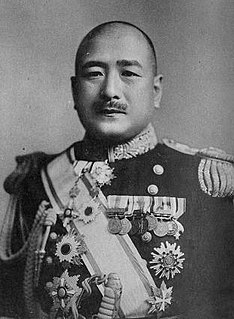 W
WBaron Kiyokazu Abo was an admiral in the Imperial Japanese Navy, who served as Navy Minister in the early 1930s.
 W
WCount Kabayama Sukenori was a Japanese samurai military leader and statesman. He was a general in the Imperial Japanese Army and an admiral in the Imperial Japanese Navy. He later became the first Japanese Governor-General of Taiwan during the island's period as a Japanese colony. He is also sometimes referred to as Kabayama Motonori.
 W
WMarshal-Admiral Viscount Katō Tomosaburō was a career officer in the Imperial Japanese Navy, cabinet minister, and Prime Minister of Japan from 1922 to 1923.
 W
WMurakami Kakuichi was an admiral in the Imperial Japanese Navy, and served as Navy Minister in the early 1920s.
 W
WOsami Nagano was a Marshal Admiral of the Japanese navy and one of the leaders of Japan's military during most of the Second World War. In April 1941, he became Chief of the Imperial Japanese Navy General Staff. In this capacity, he served as the navy's commander-in-chief in the Asia-Pacific theater until his removal in February 1944. After the war, he was arrested by the International Military Tribunal for the Far East but died of natural causes in prison during the trial.
 W
WViscount Nire Kagenori was a Japanese admiral in the early Imperial Japanese Navy, and served as Navy Minister in the late 19th century.
 W
WNaokuni Nomura was an admiral in the Imperial Japanese Navy, and briefly served as Navy Minister in the 1940s.
 W
WKoshirō Oikawa was an admiral in the Imperial Japanese Navy and Naval Minister during World War II.
 W
WKeisuke Okada was an admiral in the Imperial Japanese Navy, politician and Prime Minister of Japan from 1934 to 1936.
 W
WBaron Mineo Ōsumi was an admiral in the Imperial Japanese Navy and served twice as Minister of the Navy of Japan during the volatile 1930s.
 W
WMarshal-Admiral Marquis Saigō Jūdō was a Japanese politician and admiral in the Meiji period.
 W
WViscount Saitō Makoto, GCB was a Japanese naval officer and politician. Upon distinguishing himself during his command of two cruisers in the First Sino-Japanese War, Saitō rose rapidly to the rank of rear admiral by 1900. He was promoted to vice admiral during the Russo-Japanese War in 1904. After serving as Minister of the Navy from 1906 to 1914, Saitō held the position of Governor-General of Korea from 1919 to 1927 and again from 1929 to 1931. When Inukai Tsuyoshi was assassinated in May 1932, he took his place as Prime Minister and served one term in office. Saitō returned to public service as Lord Keeper of the Privy Seal in February 1935 but was assassinated only a year later during the February 26 Incident.
 W
WShigetarō Shimada was an admiral in the Imperial Japanese Navy during World War II. He also served as Minister of the Navy. He was convicted of war crimes and sentenced to life imprisonment.
 W
WTakarabe Takeshi was an admiral in the Imperial Japanese Navy, and served as Navy Minister in the 1920s. He was also the son-in-law of Yamamoto Gonnohyōe.
 W
WAdmiral Count Yamamoto Gonbee, also called Gonnohyōe , was an admiral in the Imperial Japanese Navy and twice Prime Minister of Japan from 1913 to 1914 and again from 1923 to 1924.
 W
WBaron Yashiro Rokurō was an admiral in the Imperial Japanese Navy and Navy Minister, succeeding the last of the Satsuma-era naval leaders of the early Meiji period.
 W
WMitsumasa Yonai was an admiral in the Imperial Japanese Navy, Minister of the Navy, and served as the Prime Minister of Japan in 1940.
 W
WZengo Yoshida was an admiral in the Imperial Japanese Navy.